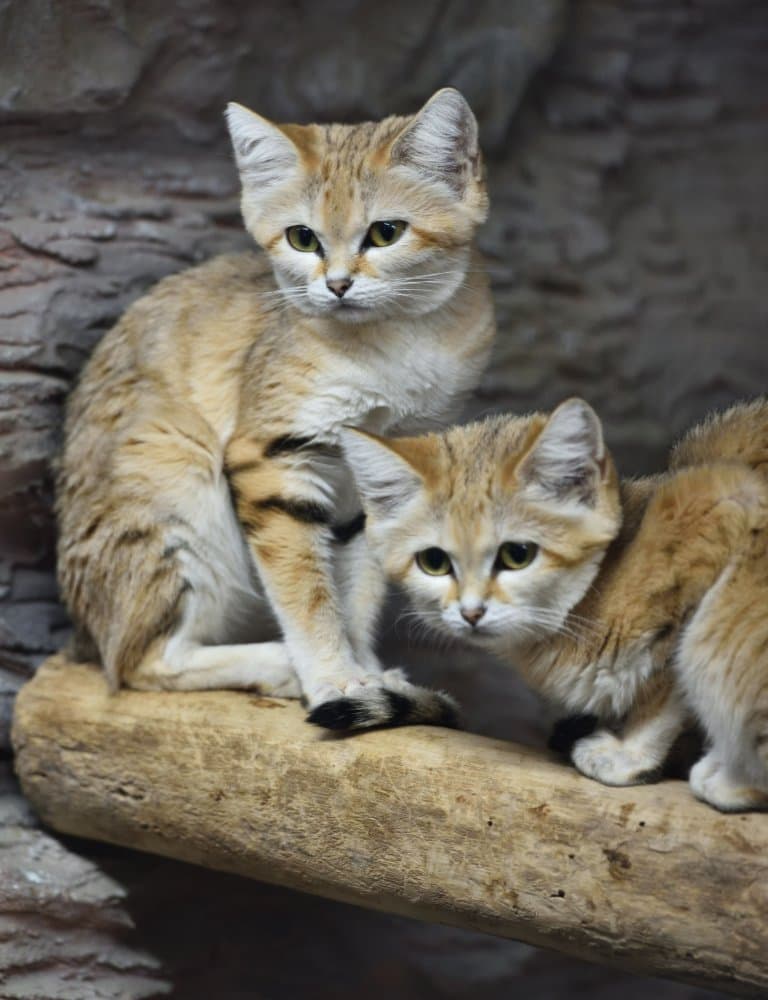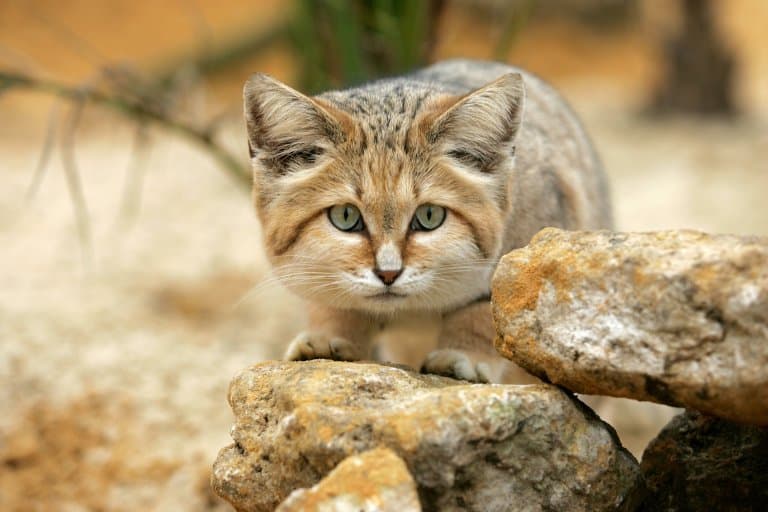Sand Cat Profile
Cats often look grumpy because they’re essentially a highly-specialised apex predator trapped in the body of an adorable cuddly toy. Being so cute when you’re supposed to be so mean is humiliating, and this gives them a sort of aloof and disdainful attitude.
If you were to take the common house cat, dial up the precision predator rating and match it with a corresponding increase in cuteness, you’d be left with the sand cat.
The single most adorable wild predator in the deserts of North Africa and Southwest and Central Asia.

Sand Cat Facts Overview
| Habitat: | Sandy and stony desert |
| Location: | North Africa, Arabian Peninsula and Southwest Asia |
| Lifespan: | 13 years in captivity |
| Size: | 40 – 52 cm (15 – 20 inches) not including tail |
| Weight: | Up to 1,800 g (4 lb) |
| Color: | Brown and grey with black bands |
| Diet: | Mostly rodents and invertebrates, some birds and lizards |
| Predators: | Caracals and wolves |
| Top Speed: | 40 kph (25 mph) |
| No. of Species: | 1 |
| Conservation Status: | Least concern |
Sand cats are a small, wild cat species from the same genus that includes the domestic house cat, European wildcat, jungle cat, African wildcat, black-footed cat and Chinese mountain cat.
They are incredible stealth hunters that live in some of the hottest places on Earth, including the Sahara desert, Arabian peninsula and parts of central Asia. They prefer dry plains with rocky valleys with sparse vegetation, rather than bare sand dunes.
In the Sahara they are known as ‘the cat that digs holes’ amongst nomads, due to their habit of digging burrows in the sand. They avoid a lot of the heat by moving mostly at night, but they’re also well-equipped to deal with extreme temperatures due to a series of impressive adaptations.
These are silent desert stalkers who hunt their prey as it burrows beneath the soil. They most hunt at night and prey on small rodents, as well as hare, birds, lizards and venoumous snakes.
Solitary and independent, they take everything we like about cats to the extreme, and sadly this similarity leads them to acquire certain sicknesses from invasive pets.
Interesting Sand Cat Facts
1. Sand cats have specialized insulated paws
The sand cat is the only cat species that lives primarily in the desert.
You might think that adding hair to an animal that lives in the desert would be a cruel trick to play, but in this instance at least, the fur is as good at keeping the heat out as it would be to keep it in.
The desert habitat of this cat can reach temperatures of over 50 degrees Celcius, and if you’ve ever struggled to walk on hot sand in bare feet you’ll understand exactly why this cat has fur on its soles. Deserts can also be extremely cold at night!
But there’s another reason. This fur helps to dampen the sound of each footstep as the cat patrols the desert, stalking its subterranean prey.
Prey it can’t even see! 1

2. They have large thermoregulating ears
Another adaptation to this arid world is shared among many mammals who live in the desert. Wide ears offer two advantages for the sand cat: being able to hear its burrowing prey, and acting as a thermoregulator.
Many animals here have a high surface area on their ears that allows them to pump lots of blood into the skin to radiate away body heat.
In the sand cat, these ears are also exceptionally wide, giving them not only a wider scope for directional hearing but also an ear canal that’s about twice the size of a domestic cat.
The extra volume in the ear canal can pick up much lower volume from desert soils, around 8 dB (five times) greater than the domestic cat.
3. They have a 4-layer coat
The extra fur doesn’t stop at this cat’s paws, either. They have thick and dense underfur that contributes to their even cuteness-to-killer ratio.
They’re born with this fur, and while it does get a little lighter in the Summer than the Winter, it’s essentially a 4-layer fur coat and acts as excellent insulation from the elements. 2
4. They grow up fast
From beginning life as a 40g fluffball to chomping down on subterranean rodents can take as little as four months, but usually is achieved in 5 or 6.
Young grow at a rate of around 12g per day in their first three weeks. To put that in perspective, a human baby adds about 30g a day for the first month, yet is over sixty times the mass.
They also have hardly any fur and take much longer than six months to start bringing home the bacon.

5. They give a nasty nip
Despite being about 30% smaller than their North African neighbour the Rüppell’s fox, they can bite almost twice as hard.
Pound-for-pound, this cat delivers significantly more pressure on its canines than the fox, using it to rapidly dispatch mammalian prey.
This reflects its reliance more on mammalian prey than the fox, who will feed more generally on inverts. 3
6. They are fearless snake hunters
Their heightened senses and agile cat movement help them dispatch of venonmous horned vipers and sand vipers. They stun the snake with blows to the head using its paws, before biting their neck.
7. They survive without drinking water for weeks
Sand cats get most of the liquid they need directly from their prey, which is useful when living in their generally waterless desert environment.
However, sand cats will drink water if available, and Sahara natives ‘The Toubou’ have reported incidents of sand cats drinking fresh camel milk from their camps at night.
8. They tolerate one another
Sand cats live in burrows. They spend the best part of the day inside the burrow, hiding from the immense desert heat, coming out at night to hunt.
They’ve been seen sharing burrows, but never at the same time. Instead, they take turns, occupying it in shifts.
Sand cats are almost entirely solitary, so this is a way to avoid squabbles while maintaining their independence.
9. They share a name with a cocktail
Their scientific name is ‘Felis margarita’, but this has nothing to do with the cocktail.
They are named after the French General Jean Auguste Margueritte who discovered the sand cat species existence on an expedition in 1858.
10. They can catch cat diseases
One of the major threats to sand cats comes from imported diseases. Not only do domesticated cats compete for prey and wipe out local mammal and bird populations wherever they go, but they also bring some nasty surprises in their blood.
Feline leukaemia virus is a coronavirus that affects cats and can cause cancer. Toxoplasmosis is a parasite that domestic cats give to their owners that makes cat people so mental. Both of these are transmitted to sand cats to cause them problems. 4

11. They might be doing OK
Habitat destruction and illegal animal trading are also putting strain on wild populations, but they do seem to be doing relatively well.
Hunting of sand cats is prohibited in over half the regions it inhabits, with no legal protection in regions such as Egypt, Mali, Morocco, Oman, Saudi Arabia, and the United Arab Emirates.
While locally extinct in some regions like Israel, and Mediterranean populations are approaching ‘threatened’, the overall population is listed as least concern by the IUCN.
Still, estimates are based on limited information, and populations are hard to monitor. This is a rare and elusive cat that lives in places field researchers can barely handle, so it’s not surprising that we know so little about them. 5
Sand Cat Fact-File Summary
Scientific Classification
| Kingdom: | Animalia |
| Phylum: | Chordata |
| Class: | Mammalia |
| Order: | Carnivora |
| Family: | Felidae |
| Genus: | Felis |
| Species Name: | Felis Margarita |
Fact Sources & References
- G. Huang, J. Rosowski, M. Ravicz & W. Peake (2002), “Mammalian ear specializations in arid habitats: structural and functional evidence from sand cat (Felis margarita)“, SpringerLink.
- Cole F. Russell, Wilson, Don E (2015), “Felis margarita (Carnivora: Felidae)“, Mammalian Species.
- Christiansen Per & Wroe Stephen (2007), “BITE FORCES AND EVOLUTIONARY ADAPTATIONS TO FEEDING ECOLOGY IN CARNIVORES“, Ecological Society of America.
- Amy Kraft (2016), “Common cat parasite linked to angry outbursts in humans“, CBS.
- Sliwa, A., Ghadirian, T., Appel, A., Banfield, L., Sher Shah, M. & Wacher, T. (2016), “Felis margarita“, The IUCN Red List of Threatened Species.
